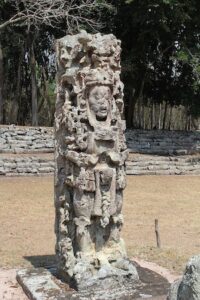
Copán, Honduras, Stela F, 18 Rabbit, Author Arian Zwegers, Brussels, Belgium, 23 April 2014, CCA-SA 4.0 International license.
The Cultural Property Advisory Committee will meet in virtual “open session” for one hour on September 19, 2023 to hear testimony on both a new request for import restrictions from Nepal and on Honduras’s request for renewal of a 20 year old agreement[1] under the 1983 Cultural Property Implementation Act to restrict import of virtually all art and artifacts for five more years[2].
Throughout the twenty year period that Honduras has had this agreement, it has failed to:
-
- do more to protect archaeological sites,
- enable U.S. students and scholars to study and research without traveling to one of the most violent countries in the world,
- allow a lawful, permitted trade in duplicative objects, or
- loan artworks to U.S. museums to make up for this blockade of its art.
The Cultural Property Advisory Committee will take public comment for three to five minutes per person on the renewal of the Honduran Memorandum of Understanding (MOU) and the new Nepalese request for a 5-year long MOU. To participate in the virtual hearing, Please follow this link to comment or participate. The deadline to submit written comments or to request to speak in the virtual open session is September 12, 2023 at 11:59 pm (EDT).
A renewed Honduran MOU would prohibit import of all Honduran pre-Columbian archaeological material until 2028. The MOU would cover all ancient artifacts from 1200 BC to AD 1500 as well as ecclesiastical ethnological material from AD 1502 to 1821.[3]
The import restrictions will make it more difficult for U.S. citizens, including citizens of Honduran, El Salvadorean and other Central American backgrounds, to see, study, and enjoy this important Mayan cultural heritage.[4] Most importantly, the Honduran request does not meet the legal requirements of the Cultural Property Implementation Act, the U.S. law that governs cultural property agreements. Despite twenty years of restrictions – despite the fact that the U.S. is emphatically NOT a market for looted Honduran antiquities and ecclesiastical antiques, the Honduras MOU is likely to be renewed. Although Congress never contemplated permanent, broadly restrictive – even blanket MOUs, the Department of State persists in arguing that they are somehow beneficial, without providing evidence that that the MOU has had any positive effect within Honduras.
Honduran archaeological sites remain at risk as a result of uncontrolled destruction of protected lands for grazing, illegal mining, and other commercial activities that have nothing to do with archaeology or looting. Despite its assurances to the contrary, the Honduran government has failed to make any effort to protect thousands of lesser-known sites or to provide even the most basic funding to its cultural authorities for archaeological protection.
The Cultural Property Advisory Committee (CPAC) at the Department of State is tasked with reviewing requests for MOUs with foreign nations and making recommendations to the President. The State Department does not have to agree with the committee’s recommendation, or make it public, although State is supposed to inform Congress when it alters the committee’s recommendation to the President Since the CPAC moved to the Department of State in 1999, an activist, anti-market, anti-collecting perspective at State’s Cultural Heritage Bureau and the selective appointment of committee members that share this bias has meant that the U.S. now has agreements granting import restrictions with more than thirty countries, all of them repeatedly renewed, including with Afghanistan, Pakistan, Libya, Yemen, Syria, Turkey, Egypt and China.
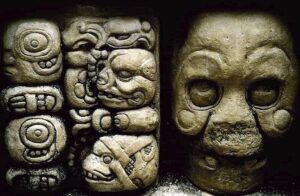
Reliefs of Maya glyphs and a skull; Copán Archaeologic Site, Honduras, Maya archaeological site of Copán. Honduras, 29 December 2004, Author LBM1948, CCA -SA 4.0 International license.
The hamburger, not looting, is driving archaeological destruction
The chief threat to archaeological sites in Honduras today is not looting for art treasures. It is the illegal expansion of beef farms into the forest. It is not the looter that threatens the preservation of Honduran archaeological sites – he, at any rate, is more likely to be deterred by the threat of devastating local diseases such as leishmaniasis than prison. The greatest threat is commercial land exploitation for the fast-food ground beef market. As Chris Fisher, the lead U.S. archaeologist for the Honduran National Geographic expedition stated, “To lose all this over a burger, it’s a really hard pill to swallow.”[5]
The 2021 election of center-left Honduran President Xiomara Castro Sarmiento, the wife of former President Manuel Zelaya (2006-2009), removed the right-wing National Party from a 12-year rule whose most outstanding characteristic was its corruption. (The last Honduran President, Juan Orlando Hernandez, was extradited to the United States in April 2022 on charges of participating in a cocaine-importation conspiracy and related firearms offenses.) Although President Castro has promised to fight corruption and inequality, and to halt the open-pit mining causing irreparable damage to rainforests and threatening the existence of poor communities in protected areas, she has not done so. Indigenous and environmental activists continue to be killed by assassins while police look on[6] and illegal land grabs and deforestation have continued under her administration.
The pervasive corruption and entanglement of criminal networks in ranching and mining, in which every narco-trafficker “wants to be a cattle rancher” has left the forests and the archaeological sites they conceal vulnerable to bulldozing, burning, and complete destruction. Raising cattle has supplanted cocaine in some locales, and the antiquities trade, always a miniscule part of Honduran criminal activity, is even less attractive to criminals. The absence of a viable U.S. or European market for recently looted Honduran antiquities does not protect sites, however. Archaeological sites inside ‘protected areas’ are bulldozed for pastureland anyway, as the antiquities they hold aren’t worth the trouble of excavating.
The Current Situation: A Government Beholden to Big Business and Crime Bosses

Detail of Building 10; Copán Archaeologic Site, Honduras, Maya archaeological site of Copán. Honduras, 29 December 2004, Author LBM1948, CCA -SA 4.0 International license.
Honduras’ government cannot control the influence of the cartels, even when it desires to do so. For most of the two decades of the U.S. – Honduras MOU, the government has worked with the cartels, rather than against them.[7] Honduras is the second most violent country in Latin America and has the highest number of murders of women in the region. The U.S State Department’s 2022 Report on Human Rights Practices in Honduras reports:
“Significant human rights issues included credible reports of: unlawful or arbitrary killings, including extrajudicial killings; torture and cases of cruel, inhuman, or degrading treatment or punishment by government agents; harsh and life-threatening prison conditions; arbitrary arrest or detention; serious restrictions on freedom of expression and media, including threats to media members by criminal elements; serious government corruption; lack of investigation of and accountability for gender-based violence; and crimes involving violence or threats of violence against Indigenous and Afro-descendant communities,”[8] (and also against LGBTQ+ citizens).
“Criminal groups, including local and transnational gangs and narcotics traffickers, were significant perpetrators of violent crimes and committed acts of homicide, torture, kidnapping, extortion, human trafficking, intimidation, and other threats and violence directed against human rights defenders, judicial authorities, lawyers, business community members, journalists, bloggers, women, and other vulnerable populations. The government investigated and prosecuted some of these crimes, but impunity was widespread.”[9]
In January 2023, the two co-founders of a grassroots environmental resistance group were murdered while making deliveries for work in a busy market in northern Guatemala. They had been fighting an illegal iron-ore mine inside a national park that is destroying rivers that communities depend upon for water. The two local activists had been subjected to false arrests and imprisonments by local and federal police for five years. In her election campaign Xiomara Castro promised to reinstate the rule of law and protect environmental defenders, but the mine continues to operate. The government claims that the activists were mugged but the killers fled without taking their moped, cellphones or money.[10]
Under the previous regime, the National Police of Honduras were considered the most corrupt in Latin America. Currently, Honduras still scores 23 (highly corrupt) on a zero to 100 highest to lowest corruption scale and ranks 157th out of 180 countries in most corruption in the world.[11] Honduras’ very high corruption score has remained steady despite the change in regime. Castro’s failure to follow through on reforms has left her supporters upset and major donors to Honduras like the U.S. worried.[12]
Archaeological Sites Neglected, Without Surveillance or Protection
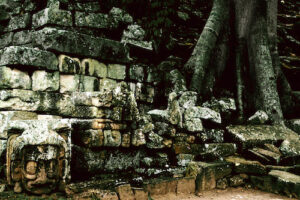
Detail of the pyramid 16, with a tree; Copán Archaeologic Site, Honduras, Maya archaeological site of Copán. Honduras, 29 December 2004, Author LBM1948, CCA -SA 4.0 International license.
Honduran tourist authorities promote archaeological tourism with tales of an estimated 140,000 sites, the vast majority undiscovered, and some 2000 known archaeological sites.[13] Of the known sites, the majority are not protected or surveilled. Except for the “important” sites such as Copan, El Puente, Los Naranjos, Curreste and Las Cuevas de Talgua, the status of thousands of archaeological sites ranges from almost no government protection to no protection at all.
The Río Plátano Biosphere Reserve is the largest protected area in the country, 350,000 hectares (over 1,350 square miles). Rio Plátano was placed on the UNESCO’s World Heritage List in Danger in 2011 as a result of illegal logging, converting jungle to pasturelands and even commercial mining in direct violation of Honduran law.[14] In addition to its extreme importance for nature conservation, the Rio Plátano was originally classified for protection for its archaeological riches in 1960 (then called the Ciudad Blanca Archaeological Reserve) and classified as a National Archaeological Park in 1969. Despite its long-term, strong legal protections, the Honduran government has failed to act to halt major commercial exploitation inside the biosphere and encroachment for cattle ranching has dramatically increased during the last decade – during two full MOUs.
The Mayan city of Copan, which dates to about the 10th C CE has been known to outsiders since it was explored in 1576 by the Spanish soldier Diego García de Palacio. It is one of the greatest Mayan cities of the Classical Maya Period (300-900 CE). The site was listed as a World Heritage Site of Universal Human Value by UNESCO in 1980 and has been protected under Honduran law since a Presidential Decree of 1982. However, UNESCO reports that Copan is deteriorating due to uncontrolled visitation, the high impact of archaeological excavation, encroachment on its buffer zone and other factors.[15] Despite questionable management practices, Copan is not considered at World Heritage Site in Danger. The same cannot be said even for other well-known archaeological sites which lack any designation as of world importance, such as El Puente, Los Naranjos, Curreste and Las Cuevas de Talgua, all of which are neglected. There are thousands of lesser-known sites that have no protection at all. They suffer far less from looting than from commercial encroachment, or by being left to crumble as they are taken over by jungle vegetation, like Comayagua/La Paz.[16]
“In the case of Tenampua, it has 250 mounds of stone and mud that are partially destroyed. The most outstanding thing that has remained is the 155-meter-long wall… 1,200-year-old pieces from the Post Classical era have been found… In the same community of Las Mercedes there are around 100 meters of rock painting engraved in stone, along the bank of the ravine that crosses the area.”
“El Chircal dates from the year 2000 BC and currently the only thing left standing are two stone mounds. The place is fenced with barbed wire, surrounded by private properties and basic grain crops. According to promoter Jose Santos Torres, there is no presence of the Honduran Institute of Anthropology and History (IHAH) at the site of national interest. “The mounds are in the custody of the IHAH but their presence does not exist, people are cultivating 10 meters away from these vestiges and they even use it as a garbage dump and it looks bad,” he said.”[17]
Urban sprawl over archaeological sites is rampant; developers building malls and parking lots do not bother to get archaeological clearances. Colonial neighborhoods are being paved with asphalt by government crews. Utility equipment finds convenient homes on archaeological sites. There is a disjunct between the supposed protections under Honduran law and how its government ‘manages’ or rather, fails to manage protected sites.[18]
The United States government contributes as much as the Honduran Government to the preservation of Honduran heritage.

Stela detail; Copán Archaeologic Site, Honduras, Maya archaeological site of Copán. Honduras, 29 December 2004, Author LBM1948, CCA -SA 4.0 International license.
The Honduran government simply does not fund cultural heritage preservation.[19] The Honduran Institute of Anthropology and Historia (IHAH), had a budget in force for the Year 2022 of L 1,112,250, which at current rates is equal to $45,157.58.[20] There are over 2,000 recorded archaeological sites. Sites are expected to pay for themselves though tourist fees.
Compare this to funding provided to Honduras through the U.S. State Department’s Ambassador Fund for Cultural Preservation. The U.S. government has funded the preservation of Honduran cultural heritage with 12 grants since the 2001inception of the Ambassadors Fund.[21] The largest of these are six grants totaling $468,200 to Honduras’ Instituto Hondureno De Antropologia e Historia (IHAH), four for the restoration and conservation of objects at the Cathedral of Comayagua and the CPAIG initiative project, described as “safety and education for the protection of the cultural heritage in Honduras.” Two small grants to IHAH of $55K and $30K respectively were for general training workshops and a Palenque cultural preservation project.[22]
What else has Honduras done to preserve its own heritage?
Prior to 2018, Honduras’ Instituto Hondureno de Antropologia e Historia (IHAH) documented online records of hundreds of items of ecclesiastical materials stolen from churches.
This is a very positive step that will enable return of any of these objects if they were stolen under Section 19 U.S.C. § 2607 of the CPIA without the need for any kind of MOU.
Such other documentation and excavation of archaeological sites in Honduras has taken place through independent projects such as the international, interdisciplinary project MayaArch3D, and the work of notable U.S. archaeologists working in Honduras, such as Dr. Christopher Begley and CPACs former member Rosemary Joyce, operating with funding from foreign sources.
It is noteworthy that there are very few finds of artifacts from the types of excavation now possible in Honduras. In fact, even National Geographic’s ‘treasure hunting’ specials, which routinely make both treasure and looting the focus of their coverage, found neither.[23]
The Requesting Country has Provided No Meaningful Basis for Public Review or Renewal
An MOU may only be renewed if the factors justifying entering into the MOU still exist. Since the MOU was first signed in 2004, neither the Government of Honduras nor the Department of State have provided information to the public supporting the request for renewal or providing evidence of Honduras’ compliance with the required self-help provisions of the Cultural Property Implementation Act. Yet there are statutory requirements that must be met for any request or renewal, and the provisions of the CPIA require both an interim and 5-year review by the Cultural Property Advisory Committee to determine whether there is a cause for suspension of the agreement under Section 2602(d) of the CPIA, and whether the obligations established for each party to the agreement have been met.
Has Honduras Met Its Commitments in Article II of Past MOUs?
The simple answer is NO. Honduras is just one of multiple nations that have signed MOUs under the CPIA with the US, but have avoided fulfilling their commitments under these agreements, including by failing to inventory art and artifacts, or to devote the necessary resources to protect archaeological sites from looting.
However, Honduras is no longer even being asked to demonstrate a good faith effort to comply with the CPIA. In the last 2019 MOU the State Department took steps to effectively eliminate accountability and any measure of responsibility to meet the Four Determinations the CPIA requires.
In its July 2018 testimony on Honduras’ request for renewal, the Association of Art Museum Directors (AAMD) strongly objected[24] to Honduras’ continuing failure to show that it was protecting its cultural patrimony (Determination 2[25]) or that the MOU supported the interchange of cultural property (Determination 4[26]) The AAMD noted in in its 2018 testimony that Article II of the 2014 MOU included requirements for Honduras to use its best efforts to register archaeological and ethnological material, register archaeological sites, work to facilitate long term international loans for exhibition, to engage with its domestic police and customs agencies with responsibility for policing, protecting sites and stopping illegal trafficking, to enforce laws protecting cultural property and prosecute crimes, to report thefts to national and international authorities, to cooperate in research, train archaeologists and museum personnel and to report to the U.S. on its progress and steps taken in advance of any further application for renewal.[27]
How did the Department of State respond to Honduras’ failure since 2014 to work towards Article II goals and report on them?
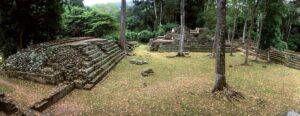
Maya archaeological site of Copán. Honduras, 29 December 2004, Author LBM1948, CCA -SA 4.0 International license.
The State Department eliminated all the provisions of the 2014 MOU’s Article II that Honduras had failed to comply with or completely ignored from the 2019 renewal agreement, including the requirement to report to the U.S. on progress.
The proposed Honduras renewal not only continues a pattern of secrecy about countries’ performance under MOUs by the Cultural Heritage Bureau at the Department of State. It denies CPAC and the public the ability to respond fully to proposed renewals. Further, it gives Honduras a “pass” enabling it to avoid showing it has even tried to comply with the U.S. law’s requirements for renewal in 2018 and now again in 2023.[28]
Honduran Laws on Heritage Exist on Paper, Not in Fact
Honduran law requires registration of cultural goods.[29] However, no registry except for Church-owned objects exists, at least nothing that is publicly available. There is no online listing of archaeological materials or effort to document the inventories of museums or educational institutions or to document any thefts that have taken place, or to register archaeological sites. What is deemed ‘National Cultural Property’ includes all public, all submerged, all library and archival and ecclesiastical property, even if it is now family-owned. [30]
What Criteria Must Be Met Under the Law for an Agreement Under the CPIA?
The request must satisfy all four requirements set forth in the statute. The requirements are:
- The cultural patrimony of the State Party is in jeopardy from the pillage of archaeological or ethnological materials of the State Party.
- The State Party has taken measures to protect its cultural patrimony.
- The application of the requested import restriction if applied in concert with similar restrictions implemented, or to be implemented within a reasonable period of time, by nations with a significant import trade in the designated objects, would be of substantial benefit in deterring a serious situation of pillage, and other remedies are not available.
- The application of the import restrictions is consistent with the general interest of the international community in the interchange of cultural property.
The current MOU does not meet these requirements and it should not be renewed. Mark B. Feldman, the chief negotiator for the Department of State in the enactment by Congress of the CPIA has stated: “The purpose of the program is not to keep art at home, but to help protect archeological resources from pillage; the findings required by the CCPIA were established for that purpose.”[31]
The Honduras renewal request covers all imports within a date range rather than listing objects actually at risk of pillage. It sets no threshold whatsoever for distinguishing what is of “cultural significance.” Congress intended that import restrictions apply to only “a narrow range of objects…”[32] The Honduras request would cover virtually everything.
Generic items and items not currently subject to looting are not covered in the CPIA. Congress did not intend import controls to extend to “trinkets or to other objects that are common or repetitive or essentially alike in material, design, color or other outstanding characteristics with other objects of the same type…”[33]
The State Department has stretched the statutory criteria far beyond the bounds of reason to prohibit importation of Colonial and Republican period, Catholic religious paintings. “Ethnological” materials must fit Congress’ statutory description of “products of a tribal or non-industrial society.”[34]
The Requirement for Similar Restrictions By Major Market Nations is Not Met.
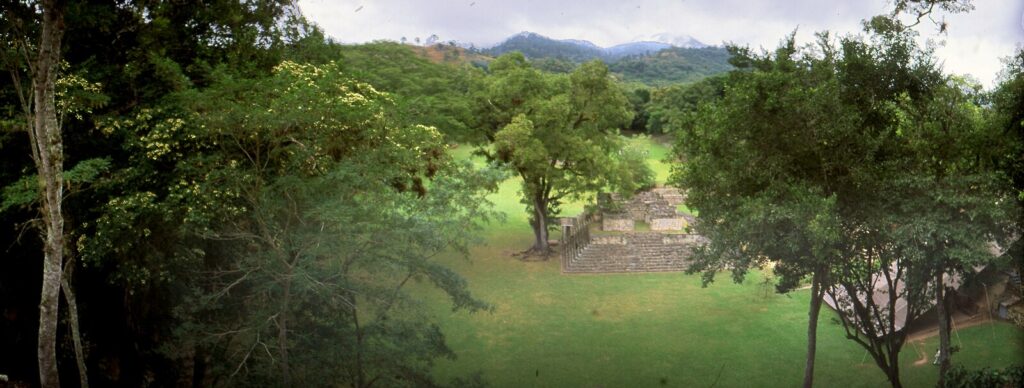
Maya archaeological site of Copán. Honduras, 29 December 2004, Author LBM1948, CCA -SA 4.0 International license.
Honduras is signatory to a variety of international instruments, from the 1954 UNESCO Convention (Hague Convention) (signed in 2003) to the 1970 UNESCO Convention (in June 1979), 1995 UNIDROIT Convention (in February 2014), and 2001 UNESCO Convention on the Protection of the Underwater Cultural Heritage (in October 2010). None of these constitute similar restrictions to the CPIA.[35] The CPIA provides under Section 2602(d), the President shall suspend an MOU if, after a reasonable period of time, other art importing countries have not implemented “import restrictions” that are similar to our import restrictions. In fact, the most valuable auction sale of a Honduran item was in Italy, and an export permit was available, in a country that severely restricts imports and exports. (See below)
MOUs Must be of Substantial Benefit in Deterring Pillage
Restricted imports must be subject to pillage and US import restrictions must be of “substantial benefit” in deterring such pillage. This raises multiple issues.
(1) Past MOUs have had overly broad or ambiguous categorizations of materials and Honduras has not shown a need for such broad protections.
(2) If there have been 20 years of import restrictions and the same broad categories continue to require the “protection” of import restrictions, the past MOUs have clearly NOT been effective and should be abandoned.
(3) In order to grant an MOU because it is of “substantial benefit” in deterring a market in the US, then there must be a showing that a significant market in Honduran materials in the US exists in the first place.
Global Sales of Honduran Antiquities Show Minimal Commercial Interest
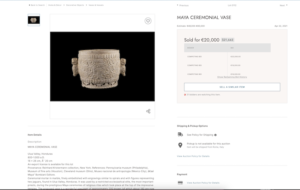
Rare Maya Ceremonial Vase, Ulua Valley, Stone, sold EU 20,000 (ex-Reinhard Kristermann collection, NY, previously exhibited and published, University of Pennsylvania Museum of Archaeology and Anthropology Philadelphia, Museum of Fine Arts Houston, Cleveland Museum of Art, Museo Nacional de Antropologia Mexico City), and sold with export permit from Italy.
There is no significant U.S. market in Honduran antiquities and there has not been since the early 2000s. With respect to current sales, a search under Pre-Columbian materials from Honduras on eBay in August 2023 turned up only one ceramic item over $1000, one under $400, a number of obvious stone fakes being sold from Canada, and two 19th century silver machine struck coins. A search for sales of Honduran art on Live Auctioneers, the foremost aggregator of auction sales for upcoming auctions globally showed only one current auction for Honduran material in Barcelona, Spain, selling one ceramic bowl and two rattles from Honduras-El Salvador: the total estimate was $2000.[36] All other global sales items from Honduras currently offered are stamps, maps, or contemporary folk art.
Past sales are equally scarce. There were no Christie’s sales of Pre-Columbian items from Honduras recorded in the U.S., and sales of seven Pre-Columbian items from Honduras in 2000 and 2001 at Sotheby’s. All Sotheby’s auction house sale of Pre-Columbian items from Honduras subsequent to 2001 were in Paris. Starting in 2013, the only auction sales recorded via Live Auctioneers were:
- 2013 – USA – Mayan Ulua Valley Banded Vessel, sold $2,000 (ex-US Andy Warhol Collection)
- 2013 – USA – Cylinder vessel, sold US $2,500
- 2014 – Portugal – 5 archaic containers in Maya terracotta, sold EU 3,500
- 2015 – USA – 2 Mayan Polychrome Cylinder vases, each sold $4,500 (ex-US Olan Collection)
- 2018 – USA – Footed Cylinder vessel, sold US $2,500
- 2019 – USA – Polychrome cylinder vase, 2 more ceramics, sold $4,800 (ex-US Gans Collection)
- 2019 – Switzerland – Mayan Ulua Valley Stone Vessel, sold CHF 6,800 (prior provenance from 2 French galleries and a French private collection)
- 2021 – Italy – Maya Ceremonial Vase, Ulua Valley, Stone, sold EU 20,000 (ex-Reinhard Kristermann collection, NY, previously exhibited and published)
- 2023 – USA – plate, sold $4,000 (previously sold USA Sotheby’s 1997)
Andy Warhol’s Honduran Antiquity Sold for 1/3 of the Price of His Cookie Jars
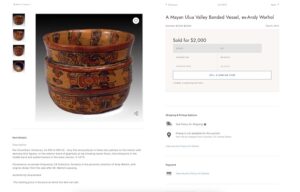
Auction sale record, Pre-Columbian Honduran ceramic, ex-Andy Warhol Collection, sold $2000. Artemis Gallery, Live Auctioneers record.
When assessing the small size of the antiquities market in comparison to common U.S. collectibles, is illuminating to compare the sale of Andy Warhol’s collection of 39 old American cookie jars, which were originally estimated at $75-$250, depending on rarity. They sold for $247,830 in 1987, realizing over $6,000 each.
Not even a celebrity association with Warhol made a Honduran antiquity more valuable. In 2013, a U.S. auction house offered a fine Honduran terracotta jar in three tiers, documented from the collection of Andy Warhol, sold together with the original sticker from the highly touted sale held after the artist’s death. After passing through an LA private collection and another auction, Warhol’s jar sold in 2013 for $2000, a good price for the item but less than one-third of the value of a Warhol-owned cookie jar.
Import Restrictions Are Not in the General Interest of the International Community in the Interchange of Cultural Property
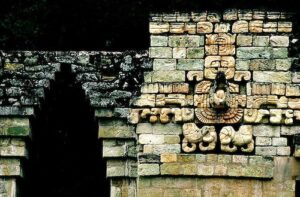
Detail of Building 10; Copán Archaeologic Site, Honduras, Maya archaeological site of Copán. Honduras, 29 December 2004, Author LBM1948, CCA -SA 4.0 International license.
The imposition of import restrictions must be consistent with the general interest of the international community in the interchange of cultural property. [37] When the 2014 renewal was pending, the AAMD submitted testimony stating that while up to 40 of its museum members had indicated an interest in exhibitions or long-term term loans, none had experience with long-term loans because, “Honduras has refused to make loans for more than one year.”[38] Such time limits preclude loans to U.S. museums. CCP was unable to locate any recent traveling exhibitions of Honduran art and artifacts covered by the MOU in the U.S. Unless Honduras can demonstrate that its loans to U.S. museums are an adequate substitute for the freedom of U.S. museums to acquire objects, it has not met this statutory requirement.[39]
The Committee must also make a determination that a memorandum of understanding is achieving its purposes, especially in light of its twenty years of comprehensive export restrictions. (19 USC §2605 (g)(1)). It is not enough to speculate that in the absence of an MOU, looting would be worse. Unless there is any real evidence that looting has been significantly reduced in the last 20 years as a result of the MOU, and that awareness inside of Honduras of the existence of the US-Honduras MOU has improved the status of local archaeological sites, there is no logical justification for continuing it.
Recommendations
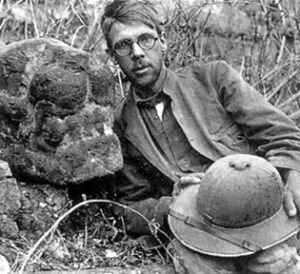
Photo of Mayanist scholar, Sylvanus G. Morley; taken c.1912 (photographer unknown) in Copan, Honduras.
The Honduras MOU cannot be legally renewed under its current terms. Under no circumstances should restrictions be applied to items that are neither archaeological nor ethnological in character according to the standards set in the statute and elucidated by the Senate in its deliberations.
The United States should not serve as sole international policeman for the protection of Honduran cultural property. Honduras should be held accountable to reasonable benchmarks set by Congress when it mandated self-help measures. Self-help measures by source countries, especially source countries with a history of lax domestic enforcement and corruption such as Honduras, can only be effective through rigorous police enforcement at archaeological sites, education of the Honduran public, and by ensuring that residents in site areas have adequate alternative sources of income. The same police protections for environmental treasures that Honduran law mandates – but which the government does not provide, would halt any remaining opportunistic looting.
The CCP and GHA recommend that if the MOU is renewed, Article II should be amended to restore the requirements for documentation, for reporting on activities and progress and the other benchmarks removed from Article II in the 2019 MOU.
As a means of ensuring that ` archaeological finds do not enter either a domestic or international illegal market, we urge the Government of Honduras to provide fair compensation for chance finds, through instituting a program of rewards for reporting the location of archaeological finds and the payment of archaeological workers by the government to properly excavate them.
The Cultural Property Advisory Committee is undoubtedly aware that import restrictions for any specific country under the Act were never intended to be a permanent fixture of the United States’ customs laws. Unless CPAC can legitimately find that Honduras has made very significant strides in all the Four Determinations as a result of last five years’ MOU – and we believe that it cannot – then the twenty-year Honduran experiment has run its course. Other means of assisting Honduran cultural development that do not damage the US interests in the circulation of art, such as facilitating development of a system of rewards to finders like those implemented in Britain’s Portable Antiquities Scheme should be tried instead.
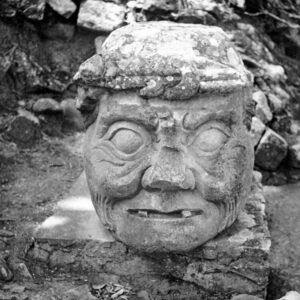
Copán Archaeologic Site, Honduras.
[1] For the most recent Honduras agreements, see 79 FR 13873, February 11, 2014, Federal Register Notice 19 CFR part 12, CPB Dec. 14-03, and 84 FR 8807, March 12, 2019, Federal Register Notice 19 CFR 12, CBP Dec. 19-03.
[2] This renewal will be stacked on top of 2004, 2009, 2014 and 2019 Memoranda of Understanding between the US and Honduras.
[3] The State Department website states: “Extending the Honduras agreement would continue import restrictions on pre-Columbian archaeological material in ceramic, stone/stucco, metal, shell, and bone, dating from approximately 1200 B.C. to A.D. 1500. Extending the Honduras agreement would also continue import restrictions on ecclesiastical ethnological material including sculpture, paintings, and metal objects, dating from approximately A.D. 1502 to 1821. The Government of Honduras has not requested additional categories of material.” https://eca.state.gov/highlight/cultural-property-advisory-committee-meet-chicago-september-19-20-2023-0
[4] Honduran import restrictions currently include all archaeological materials representing the Pre-Columbian cultures of Honduras from the Maya, Chorti Maya, Lenca, Jicaque, and Pipil and other pre-Columbian cultures.
[5] Alan Yuhas, Archaeologists find two ‘lost cities’ deep in Honduras jungle, The Guardian, 5 March 2015, https://www.theguardian.com/world/2015/mar/06/archaeologists-find-two-lost-cities-deep-in-honduras-jungle?
[6] See Nina Lakhani, Indigenous environmental defender killed in latest Honduras attack, The Guardian, 29 December 2020, https://www.theguardian.com/environment/2020/dec/29/indigenous-environmental-defender-killed-felix-vasquez.
[7] A most striking example of this may be seen in the extradition to the U.S. of former Honduran President Juan Orlando Hernandez, charged with participating in a cocaine-importation conspiracy and related firearms offenses. The fact that there is a new President since 2022 does not alter the fact that the government, police, border control and other elements pertaining to the preservation of heritage continue to be deeply tied to criminal networks. See Kanishka Singh and Luc Cohen, Former Honduras president extradited to U.S. on drugs, weapons charges. Reuters, April 21, 2022, https://www.reuters.com/world/americas/us-charges-ex-honduras-president-with-cocaine-importation-conspiracy-2022-04-21/
[8] U.S State Department, Honduras – 2022 Report on Human Rights Practices, Executive Summary, https://www.state.gov/reports/2022-country-reports-on-human-rights-practices/honduras/
[9] Id.
[10] Nina Lakhani, Honduran environmental defenders shot dead in broad daylight, The Guardian, 11 Jan 2023, https://www.theguardian.com/world/2023/jan/11/honduras-environmental-defenders-shot-dead-guapinol-mine, and Nina Lakhani, Indigenous environmental defender killed in latest Honduras attack, The Guardian, 29 December 2020, https://www.theguardian.com/environment/2020/dec/29/indigenous-environmental-defender-killed-felix-vasquez.
[11] Transparency International, Corruption Perceptions Index, 2022, https://www.transparency.org/en/cpi/2021 . See also ASJ-USA, Association for a More Just Society, Corruption in Honduras, February 2020, https://www.asj-us.org/learn/corruption-in-honduras.
[12] New Dawn or Old Habits? Resolving Honduras’ Security Dilemmas, International Crisis Group, 10 July 2023, https://www.crisisgroup.org/latin-america-caribbean/central-america/honduras/100-new-dawn-or-old-habits-resolving-honduras-security.
[13] https://honduras.travel/en/information.php
[14] UNESCO, Río Plátano Biosphere Reserve, https://whc.unesco.org/en/list/196
[15] UNESCO, Maya Site of Copan, https://whc.unesco.org/en/list/129/
[16] See Juan Cesar Diaz, “En el abandono estan los sitios arqueologicos de Comayagua y la Paz,” El Heraldo February 10, 2016, https://www.elheraldo.hn/honduras/en-el-abandono-estan-los-sitios-arqueologicos-de-comayagua-y-la-paz-BVEH1005163#image-1
[17] Id.
[18] The Instituto Hondureno de Antropologia e Historia (IHAH), which is tasked with monitoring site usage and granting permission for construction should be but is not consulted.
[19] Informe de Avance Físico y Financiero Secretaría de Finanzas Subsecretaría de Crédito e Inversión Pública Instituto Hondureño de Antropología e Historia (IHAH) Tegucigalpa, Honduras. https://www.sefin.gob.hn/download_file.php?download_file=/wp-content/uploads/2022/05/15-IHAH-al-Itrim-2022.pdf
[20] Informe de Avance Físico y Financiero Secretaría de Finanzas Subsecretaría de Crédito e Inversión Pública Instituto Hondureño de Antropología e Historia (IHAH) Tegucigalpa, Honduras. https://www.sefin.gob.hn/download_file.php?download_file=/wp-content/uploads/2022/05/15-IHAH-al-Itrim-2022.pdf
[21] The U.S. Embassy in Honduras and the Bureau of Educational and Cultural Affairs (ECA) of the U.S. Department of State are pleased to announce the 2023 open call for proposals for the U.S. Ambassadors Fund for Cultural Preservation (AFCP) Grants Program Funding Opportunity. https://hn.usembassy.gov/education-culture/afcp/
[22] See Highergov.com, https://www.highergov.com/awardee/instituto-hondureno-de-antropologia-e-historia-13352705/.
[23] See, for example, Douglas Preston, Lure of the Lost City, National Geographic, October 2015. https://www.nationalgeographic.com/magazine/2015/10/lost-city-mosquitia-honduras-monkey-god/)
[24] Association of Art Museum Directors, Statement of the Association of Art Museum Directors concerning the Memorandum of Understanding between the Government of the United States of America and the Government of the Republic of Honduras concerning the Imposition of Import Restrictions on Archaeological Material from the Pre-Columbian Cultures and Ecclesiastical Ethnological Material from the Colonial Period of Honduras, Meeting of the Cultural Property Advisory Committee July 31, 2018.
[25] 19 U.S.C.§ 2602(a)(1)(B).
[26] 19 U.S.C.§ 2602(a)(1)(D).
[27] See Appendix 1: Agreement Between the United States of America and Honduras Amending and Extending Memorandum of Understanding of March 12, 2004 As Amended and Extended Effected by Exchange of Notes at Washington, March 7, 2014, Article II.
[28] See attached Appendix 2: Memorandum of Understanding Between the United States of America and Honduras, Signed at Tegucigalpa March 5, 2019, Article II.
[29] “[The] Honduran Institute of Anthropology and History will maintain a national registry in which any Cultural Property will be registered that is held by individuals as depositories or owners, who are required to register them within a period of thirty (30) days from the date on which this Law enters into effect. (Decree No. 220-97, Art.12)”
And “Cultural Property must be duly registered with the Honduran Institute of Anthropology and History; otherwise, it will be deemed an illegal possession and must be recovered. (Decree No. 220-97, Art. 13)”
[30] “National Cultural Property’—[is] classified as follows: (1) Public—(a) all pre-Columbian property; (b) submerged cultural property; (c) documental and library resources for public use; (2) Ecclesiastical; (3) Individual (part of family or personal property, or was legally obtained at some point). (Decree No. 220-97, Art. 3)” “The works of a living artist may be declared protected cultural property if there is express authorization to do so by its owner, or if it is acquired by the State with or without valuable consideration. (Decree No. 220-97, Art. 7)
[31] Mark B. Feldman, Symposium: Reform of U.S. Cultural Property Policy: Accountability, Transparency, and Legal Certainty, Benjamin N. Cardozo School of Law, New York, N.Y. April 10, 2014.)
[32] Senate Report No. 564, 97th Cong., 2nd Sess. (1982), p. 5.
[33] Id.
[34] “While these materials do not lend themselves to arbitrary age thresholds, the Committee intends this definition, to encompass only what is sometimes termed “primitive” or “tribal art,” such as masks, idols, or totem poles, produced by tribal societies in Africa and South America.” (Senate Report No. 564, 97th Cong., 2nd Sess. (1982), p. 5)
[35] Section 2602(2)(c) of the CPIA explicitly denies the President the authority to enter into an import limitation without a showing that other major market nations have enacted similar restrictions. Otherwise U.S. agreements would simply push art and artifacts around the world. The CPIA provides that under Section 2602(d), the President shall suspend an MOU if, after a reasonable period of time, other art importing countries have not implemented “import restrictions” that are similar to our import restrictions.”
[36] From Sedart Auction House, Barcelona, Spain. https://www.liveauctioneers.com/search/?keyword=Honduras&sort=-relevance&status=online
[37] 19 USC § 2602(a)(1)(D).
[38] Statement of Association of Art Museum Directors, October 30, 2013.
[39] The December 16, 2019–June 27, 2021 Metropolitan Museum exhibition of works from early Caribbean civilizations, Arte del mar: Artistic Exchange in the Caribbean, included works from coastal societies in Colombia, Panama, Costa Rica, and Honduras, but none came from foreign loans. https://www.metmuseum.org/press/exhibitions/2019/arte-del-marThe March 3-July 30, 2023 Harvard Art Museums exhibition showed ecclesiastical works from nearby Bolivia, Ecuador, Peru, Puerto Rico, and Venezuela, but the only Honduran material was objects made from its famous mahogany, and all were from a U.S. collection belonging to the Carl & Marilynn Thoma Foundation. https://harvardartmuseums.org/exhibitions/6219/from-the-andes-to-the-caribbean-american-art-from-the-spanish-empire
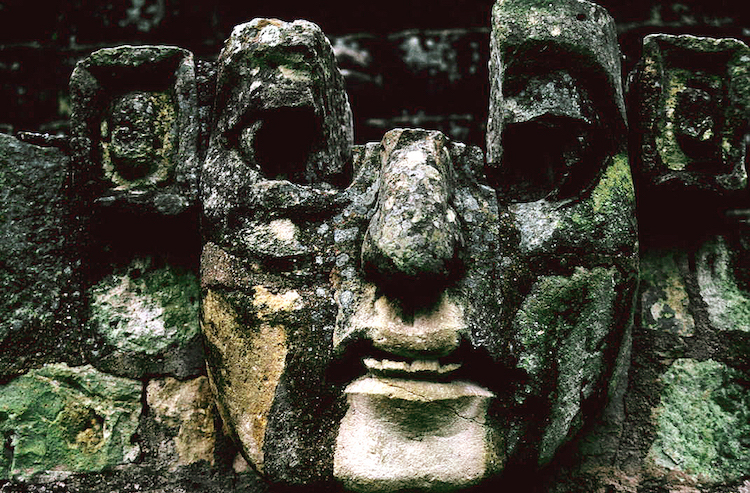 Maya archaeological site of Copán. Honduras, 29 December 2004, Author LBM1948, CCA -SA 4.0 International license.
Maya archaeological site of Copán. Honduras, 29 December 2004, Author LBM1948, CCA -SA 4.0 International license. 

